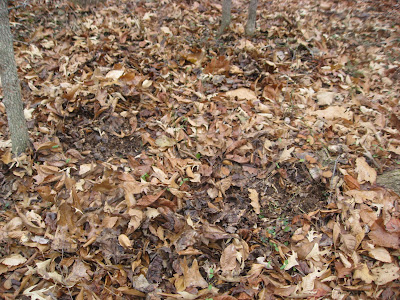 |
| The evergreen leaf of the Cranefly Orchid often has purplish bumps. |
Believe it or not, winter is one of the best times to find some of our native orchids. One of these is the Cranefly Orchid, which is also our most common. Perhaps this is because it may not be as picky of which mycorrhizal fungi it needs to survive as other North American orchids. Some other native orchids, such as the Ladyslippers, are very specific of which fungi they form a symbiotic relationship with. This is why they are not only rare, but normally cannot be moved, for if the fungi dies, so does the orchid. Cranefly orchids seem less specific of the fungi they need, but are certainly not considered common. They are considered endangered in some states.
The reason that the Cranefly Orchid stands out during winter is that it is evergreen. More so, if you flip the leaf over, it is a bright purple underneath. This makes it easy to identify and also is the reason for the second part of its scientific name: Tipularia discolor. "Tipula" is Latin for "cranefly." It is the sole member of its genus in North America.
 |
| The underside of a Cranefly Orchid leaf showing its distinctive purple color. |
Each plant has a single leaf that emerges in September or so, but they can form small colonies with the tuberous roots close together and thus look multi-leaved. The lone leaf disappears in late spring when the plant flowers, so mark the location now if you wish to see one in bloom. This winter leafing out is termed a hibernal leaf.
 |
| Cranefly orchids flowering at night, awaiting their moth pollinators. They are somewhat fragrant at night also, helping to attract Noctuid moths. |
The flowers bloom in late summer after the leaves have disappeared, often in August. They are not that showy to us, being small, but are very attractive to Noctuid moths which are the main pollinators. Almost all of the pollination happens at night. Despite their common name, they are not pollinated by craneflies. I have however seen the pollen bags (pollininara) attached to moths, often to their eyes.
 |
| Cranefly orchid flowers up close. Some say they look like craneflies aloft and that being the reason for the name. Others think it was a misunderstanding about their main pollinators. |
The small flowers are said by some to look like craneflies, leaning to one side or the other and are asymmetrical. This is said by some to have resulted in its common names of Cranefly Orchid or Crippled Cranefly Orchids. The unusual flower shape and small size has also led to another common name: Elfin Spurs.
 |
| Cranefly orchid seed pods. |
The tuberous roots (corms in botanical terms) are said to be edible and potato-like, but I've never tried them. I think they are much too uncommon to harvest. Best to leave them for the moths, especially since they are, like most orchids, a favorite of deer and so are becoming rarer every day with the rising over populations of deer. I hope to spot them on winter woodland walks for a long time to come.























.JPG)





















